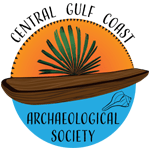Gulf Coast Archaeology: Examining Society and Climate through Material Culture
Trevor Duke, Ph.D. Candidate, University of Florida
Lindsey Parsons, M.A. Student, Geology Department, University of Georgia
Two winners of the 2019 and 2020 Alliance for Weedon Island Archaeological Research and Education (AWIARE) and Levett Foundation Grant discuss their winning research along the Gulf Coast of Florida.
Trevor Duke, Ph.D. Candidate, University of Florida
FANCY POTS FOR TOUGH TIMES: RITUAL SPECIALIZATION IN THE SOUTHEASTERN US
Abstract: Modern society is highly specialized. Most people spend years acquiring the skills necessary to become doctors, lawyers, teachers, etc., and thus depend on other specialists, like farmers or butchers, to meet their everyday needs. This type of interdependence is characteristic of state-level societies with centralized economies. Conventional wisdom tells us that hunter-gatherers are generally unspecialized, diversifying daily tasks to meet the needs of their household or village. On the contrary, archaeological evidence demonstrates that hunter-gatherer societies in the Tampa Bay region embraced different forms of pottery specialization. This presentation focuses on this observation to address a critical anthropological question: What motivates people in different societies to become specialists? I argue that the tumultuous times of the Late Woodland and Mississippian periods (AD 650-1550) created the need for a network of ritual specialists that served specific purposes for Native American communities across the Lower Southeast.
C. Trevor Duke is a Ph.D. candidate in Anthropology at the University of Florida. His research focuses on how people use labor and objects to create social relationships. His dissertation research centers around developing new methods for investigating pottery specialization in small-scale societies.
Lindsey Parsons, M.A. Student, Geology Department, University of Georgia
Abstract: The Calusa, a group native to southwestern Florida, left extensive shell mounds and kitchen middens throughout the region up to and including the 18th century. While oysters and hard clams are known food items for the Calusa, they also ate scallops, but little is known about this food resource. The purpose of this study is to determine if the Bay Scallop Argopecten irradians, found in midden deposits, provide key insights into Calusa resource use during the Medieval Warm Period and Little Ice Age climate anomalies (A.D. 850 – 1850). I focused on two localities, the Pineland Site Complex and Bayshore Homes that are both located on the Gulf Coast of Florida. I will use body size, taphonomy, and stable isotopic analysis of deposited shells to examine how climatic factors may have influenced the scallop as a food resource as well as harvesting behaviors of native communities.
Lindsey Parsons is a second-year master’s student in the Geology Department at the University of Georgia. Her focus is interdisciplinary in nature combining the practices the paleontology and archaeology to understand the resource use of scallops by native communities along the gulf coast of Florida. Her project is being funded by the Alliance for Weedon Island Archaeology Research and Education, Inc. (AWIARE)/ Levitt Foundation. She currently works as a research assistant at the Laboratory of Archaeology working on an NSF-funded project. She completed her undergraduate geology degree at the University of Georgia as well in 2013.


